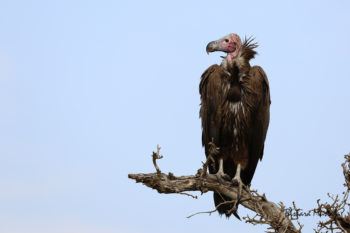Buzzards: Ugly Birds That Provide A Public Service, Expert Says

Buzzards could be called Mother Nature’s vacuum cleaner, and for good reason: they can eat things that would kill most people.
Buzzards will never win any beauty awards, and their often-seen circular flying patterns overhead seem to symbolize death. Is it any wonder this bird gets a bad rap?
“It’s a bird that is probably a bit misunderstood but it serves a very valuable service,” believes Dr. Ian Tizard, a professor in the College of Veterinary Medicine & Biomedical Sciences at Texas A&M University who also directs the Schubot Exotic Bird Center.
If ever a bird had an image problem, he says, it’s the buzzard.
To start with, the correct name is vulture, says Tizard. Buzzard has become a slang term for the bird and there are two types, both commonly found throughout much of North America. One is the turkey vulture, the other is the black vulture.
The turkey vulture is a bit larger, has a red head and when it flies, its wing tips are raised giving it a V-shaped profile. The black vulture features a black head and has some white streaks in its wings.
“Black vultures used to be fairly rare in Texas, but now you see them everywhere,” Tizard notes. “They are bolder birds – they’ll push turkey vultures aside if they wish, and often do.”
Both are known as masters of the roadkill. Their diet consists of animals that have died, either recently or weeks ago. It is that scavenging feature that makes them necessary, Tizard says.
“They clean up the countryside in a natural way, and in doing so, they provide a valuable service,” he adds.
Tizard says the vulture’s digestive system has evolved into a natural wonder itself. The bird can eat just about anything. “Handling sick or injured vultures is complicated as their natural defense is to regurgitate what they eat,” he explains.
“By eating what they have for thousands of years, they have the ability to break down just about anything inside their stomach. They are no longer sensitive to botulism toxins that would kill a human.”
Tizard says many ranchers don’t like vultures, probably because of a misconception. They often see a vulture eating the carcass of a calf or small goat “and they assume the vulture probably killed it, which is almost never true.”
Vultures are often shot at by hunters or ranchers, who see the slow-flying birds with their 5-foot wingspan as easy target practice. But in most states, the birds are protected: In Texas, you could be fined up to $500 for each bird shot.
Despite their unpeacock-like appearance, vultures are intelligent birds whose senses of sight and smell are among the sharpest of any creatures, Tizard says. And don’t forget that the California Condor, considered one of the most majestic birds, is a form of vulture, he adds.
A vulture’s head is usually bald, with no feathers to get in its way when it’s eating, and its sharp beak is perfect for tearing away flesh, Tizard notes.
And why do they always seem to fly in circles overhead?
“It’s their way of sightseeing and also looking for their next meal,” he adds.
“One will find a thermal – warm currents of air that rise off the ground – and it carries them to a higher elevation without any work. They can glide around and scout out what’s down below on land, and when one vulture sees another riding a thermal, others will ride it, too.
“But they are always watching each other,” he continues. “Black vultures like to watch what turkey vultures are looking at, and if they see one heading down for a meal, they will follow it and often take it for themselves. Turkey vultures have a great sense of smell, but black vultures have sharper vision.”
Besides sharing meals, the birds always roost together at night, Tizard says. And when daylight comes, their scavenging cycle starts all over again.
Media contact: Keith Randall, Texas A&M News & Information Services.





